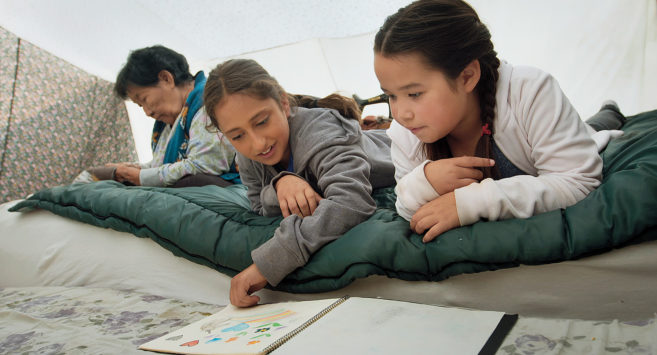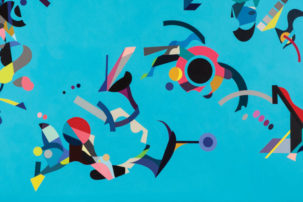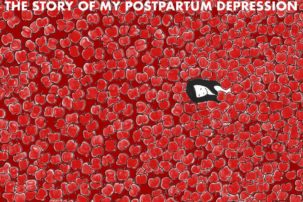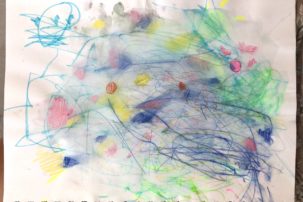“Mothering Spaces,” hosted by the Mitchell Art Gallery at MacEwan University in Edmonton, was an exhibition that changed “mother” from noun to verb. This action, and its subversion of a Euro-centric nuclear-family ideal, takes the responsibility of child-rearing imposed on an individual and places that responsibility on the collective community. Rooted in Indigenous knowledge systems and through deliberate programming, “Mothering Spaces” opened dialogue to address the barriers and inequities caregivers experience—barriers and inequities enforced by institutions, granting bodies and residencies. Curated by Becca Taylor, “Mothering Spaces” featured work by Tiffany Shaw-Collinge, Faye HeavyShield and The Ephemerals (Jaimie Isaac, Niki Little and Jenny Western).
As an Anishinaabe cultural producer, I’ve participated in a very specific facet of Canadian art culture, one in which it’s second nature for gatherings to have children running about, giggling and interacting with art. It’s come to the point that, for me, spaces absent of that activity are lacking something. The idea that the only way for children to benefit from being in cultural space is to adhere to constructed protocols is a lingering effect of the elitist image that galleries and museums spent centuries cultivating. This is a remnant of the belief that art is a “transcendent experience” only to be understood by the “enlightened.” This “enlightenment” is in direct contradiction to Indigenous social responsibilities, characterized by kinship.
Kinship is rooted to community, and Taylor’s curatorial practices integrate the processes and responsibilities associated with kinship into institutional spaces, which are often unequipped to do so. Taylor’s family is a mix of Cree, Scottish and Irish descent, and was equipped to teach the responsibilities of kinship, specifically Wahkotowin. To be clear, Wahkotowin is a complex and all-encompassing Cree epistemology, and in this essay it is being addressed in a particular context and from teachings shared with me as an individual. What I write about here is not, by any means, “the definition” of Wahkotowin. Still, it would be fair to say that Taylor was raised in a context where children are the heart of the community and all individuals are responsible for helping, loving and teaching them. Mothering, or caretaking, frames this as an act rather than something inherent, moving aside connotations and expectations and instead recognizing the communal roles people play in the lives of our children and in our future.
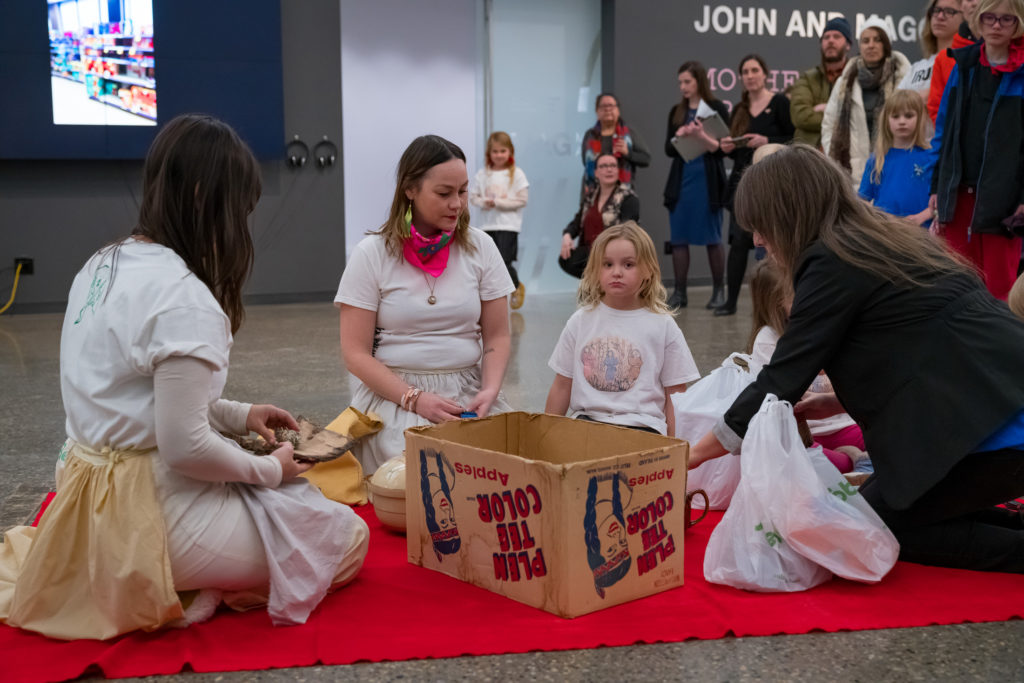 The Ephemerals and their collaborators during the performance So Bey (2019), part of “Mothering Spaces” at the Mitchell Art Gallery.
The Ephemerals and their collaborators during the performance So Bey (2019), part of “Mothering Spaces” at the Mitchell Art Gallery.
These concepts were encapsulated by The Ephemerals, who began the “Mothering Spaces” exhibition with So Bey, a performance where their children were their collaborators. The Ephemerals are a collective of artists and curators working and living in Winnipeg who have been active since 2010. Their work is rooted in matriarchal knowledge that has been shared with them and, as a result, embodies intergenerational dialogue in a good way. It’s easy to integrate children into a performance by giving them prompts and roles they need to fulfill without valuing their voices or ideas as autonomous individuals. But by providing the children here with reasoning behind the actions, and giving them the option to participate, the Ephemerkids (Isaac’s, Western’s and Little’s children, when they band together) had the autonomy to participate. I use the word collaborator to describe this relationship, but after conversations with the artists, we all agree it’s not the right one—but it’s close.
In So Bey, Little, Isaac and Western, accompanied by their children, walked along Brenda Draney’s installation Trapline, a shifting bronze line inlaid into the floor, while holding manoomin, corn and duck, and while smudging the space. The adults passed various culturally significant food items to one another, and went through the actions of showing them to and whispering about them to the children. The crowd acted as witnesses, observing the performance as the songs “Bag Lady” (Erykah Badu), “Heartbeats” (The Knife) and “Stayin’ Alive” (Bee Gees) played in the background. Each song was chosen by a member of The Ephemerals based on their relationships to their families’ past, present and future. The performance concluded with the Ephemerkids serving food, including berries, to the witnesses, redistributing their bounty. An element of So Bey speaks to the positive effects of Indigenous knowledge systems and epistemologies on all communities (and also to environmental consciousness and existing as urban Indigenous folks in this piece, but that’s another article).
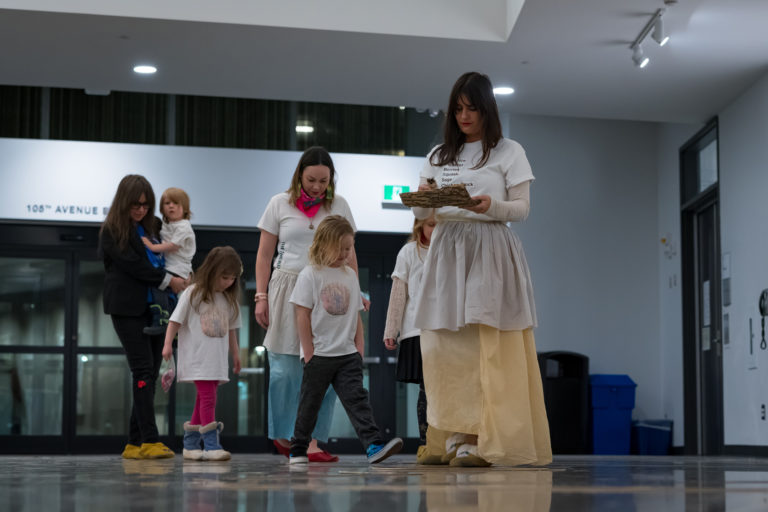 The Ephemerals and their collaborators during the performance So Bey (2019), part of “Mothering Spaces” at the Mitchell Art Gallery.
The Ephemerals and their collaborators during the performance So Bey (2019), part of “Mothering Spaces” at the Mitchell Art Gallery.
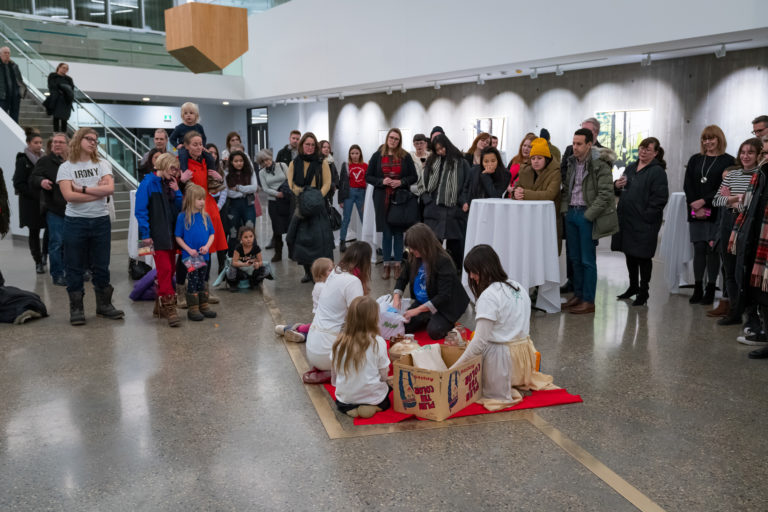 The Ephemerals perform So Bey (2019) as part of “Mothering Spaces” at the Mitchell Art Gallery. As part of the performance, the participants walked along a bronze line in the floor, part of a permanent installation outside the gallery by Brenda Draney.
The Ephemerals perform So Bey (2019) as part of “Mothering Spaces” at the Mitchell Art Gallery. As part of the performance, the participants walked along a bronze line in the floor, part of a permanent installation outside the gallery by Brenda Draney.
We live in a society that undervalues the work of womxn. It undervalues artists despite being inundated with creative media. We have a society that has constructed a hierarchal strata of artists, where the social effects of entire art movements on our communities have been essentialized to the names of a handful of people—or even a single person. This is all without even touching on the erasure of POC communities in the “meta” narratives.
It is isolating to be an artist/caregiver in Canada, especially as part of an underrepresented community such as Inuit, Métis or First Nations. Isaac, Little and Western each had their first child within the same year, and sharing that experience as new parents created a network of support (which they also acknowledge the privilege of having). Sharing that experience also provided space to have critical discussions on how mothering should reflect in their practice. The ephemera from The Ephemerals’ performance, the set-up from the feast and the video work After Birth, which integrates the voice of Elder Dr. Mary Courchene, Isaac’s nana, were all folded together and woven into layers of shared knowledge; it was an example of what that critical mothering process looks like in this trio’s collective, yet distinct, families.
The Ephemerals understand the value of the communities they belong to, communities that have been actively excluded and discriminated against by Western-Euro institutions. The Ephemerals are constantly in dialogue about how their art practices, as makers, curators and writers, are in service to—rather than served by—their community collaborators (which include the Ephemerkids).
 The exterior of the Mitchell Art Gallery during “Mothering Spaces.” During the show, the video screen to the left of the gallery entrance featured the program “Indigenous Birthing,” curated by Ociciwan Contemporary Art Collective and offering art by The Ephemerals, Jules Koostachin and Rebeka Tabobondung. Photo: Blaine Campbell.
The exterior of the Mitchell Art Gallery during “Mothering Spaces.” During the show, the video screen to the left of the gallery entrance featured the program “Indigenous Birthing,” curated by Ociciwan Contemporary Art Collective and offering art by The Ephemerals, Jules Koostachin and Rebeka Tabobondung. Photo: Blaine Campbell.
What impressed me about “Mothering Spaces” were the actions that occurred outside of the physical presence and event of the exhibition itself. (A word for these other actions could be “programming,” but that term doesn’t really describe the nature of what I experienced in a way that feels sufficient.) My Elder Barb Blind once said, “Ceremony begins the moment you decide you’re holding a ceremony.” It’s with these values that I look at art. It’s not solely when art is being gazed upon that its considered art. As artists, as cultural producers, we are constantly enacting art. It involves the communities we work with. It involves our family, loved ones, acquaintances.
When Faye Heavyshield spoke at the opening of “Mothering Spaces,” one phrase echoed throughout the installation and the events surrounding the exhibition: “Art should be ordinary. It should be part of everyday life.” Heavyshield enacted that statement when she called on children, and those who were children at heart, to come up to the stage to receive a gift (a baggie filled with thoughtful toys, markers and notepads). She prepared those gifts for them, and took time during the opening remarks to give them properly, expressing gratitude for the childrens’ presence.
Heavyshield’s words and actions aligned with her artwork time, which was included in the exhibition. It serves as another example of the importance of intergenerational values as a foundation within contemporary Indigenous artwork and epistemologies. time features a row of seven elevated drums, all playing recordings of the heartbeats of her family. While the drums are displayed in a line, the sounds cycle—so rather than being a linear work, we returned to ideas of past, present and future being simultaneous. Concepts of reverberation and presence also tie into teachings about both the hand drum and big drum. time’s elements of survivance, thrivance and continuance also tied into the dialogue of seven generations. The drums were displayed in the open, not in a vitrine, so individuals were allowed the access and opportunity to contribute to the drumming. Again, it showed that inclusivity and access benefits everyone—and these were important elements to both “Mothering Spaces” and its overarching dialogue around mothering in art.
 A view of Faye HeavyShield’s installation time (2019) in “Mothering Spaces” at Mitchell Art Gallery.
A view of Faye HeavyShield’s installation time (2019) in “Mothering Spaces” at Mitchell Art Gallery.
Tiffany Shaw-Collinge’s installation drew upon her architectural practices, where formalistic structures play with the concept of the domestic. It connected these with something as innocuous as a blanket fort, as well as with lenses of access and perspective. Passage was installed at a specific height perfect for kids to crawl beneath, but mildly uncomfortable for most adults to engage in the same way. This was a reversal of art-gallery customs, which dictate where labels are placed or how artwork is generally installed, as well as what demographic is often considered when designing an exhibition. Standing, I could admire the crisp lines and valleys Passage created on a formal level, but the experience of lying beneath the work was like viewing a completely different object.
Accompanying Passage was Three Years, a pedestal displaying the baby mocs that had been made for Shaw-Collinge’s child. This assemblage evidenced the labour of family and friends to provide him with footwear. There were also unfinished mocs made by Shaw-Collinge herself. Together, it all spoke to the energy, love and time invested by a community in one child.
 Tiffany Shaw-Collinge’s installation Passage (2019) in “Mothering Spaces” at the Mitchell Art Gallery. Photo: Blaine Campbell.
Tiffany Shaw-Collinge’s installation Passage (2019) in “Mothering Spaces” at the Mitchell Art Gallery. Photo: Blaine Campbell.
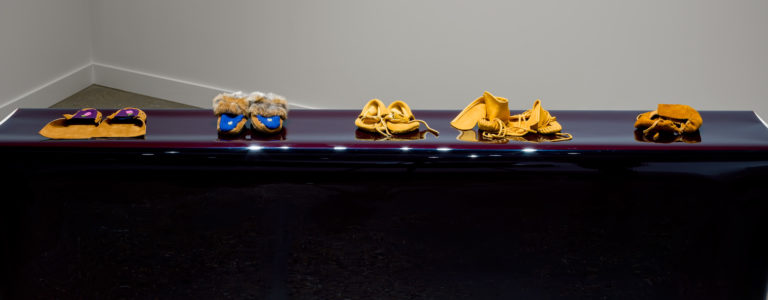 A view of Tiffany Shaw-Collinge’s Three Years (2019) in “Mothering Spaces” at the Mitchell Art Gallery. Photo: Blaine Campbell.
A view of Tiffany Shaw-Collinge’s Three Years (2019) in “Mothering Spaces” at the Mitchell Art Gallery. Photo: Blaine Campbell.
The idea of community support to raise children is a great way to segue into Becca Taylor’s and my relationship to this exhibition. It’s difficult to explain the role of Aunties as a cultural concept; all I can do is say that as individuals who participate in the lives of our nieces and nephews, we share an awareness of the labour involved in caring for family.
Taylor herself is in a caregiving role with her niece Julianna, and her relationship with Julianna and her surrounding family informs her curatorial practice. Throughout the exhibition and accompanying symposium, Taylor acknowledged the privilege of being in a profession that had the potential for flexibility and space to have Julianna present. It’s through visibility, and through destigmatizing the presence of children at meetings, openings or conferences, that our womxn-dominated field can change. What’s also needed is recognizing that the expectation of sacrificing copious amounts of personal time to be considered “professional” isn’t healthy, and isn’t something we should expect from one another.
My role as an auntie to my nieces and nephews isn’t as involved as Taylor’s, but it’s still something I take pride in. The responsibility and love I feel toward the kiddos in my family extends to the children of fellow artists, curators and friends. Writing on this topic of “Mothering Spaces” as an auntie is valid, because I’ve heard these same concerns voiced by many cultural producers over the years, with those concerns ultimately dismissed because of their status as mothers.
On reflection, it’s possible that writing on this topic as an auntie is not only valid; it’s necessary. It’s also with privilege—being regarded as a “fun big kid” by the kids and auntie by my peers—that I get to act as childcare for the kiddos at events and residencies while their parents do valuable and urgent professional work.
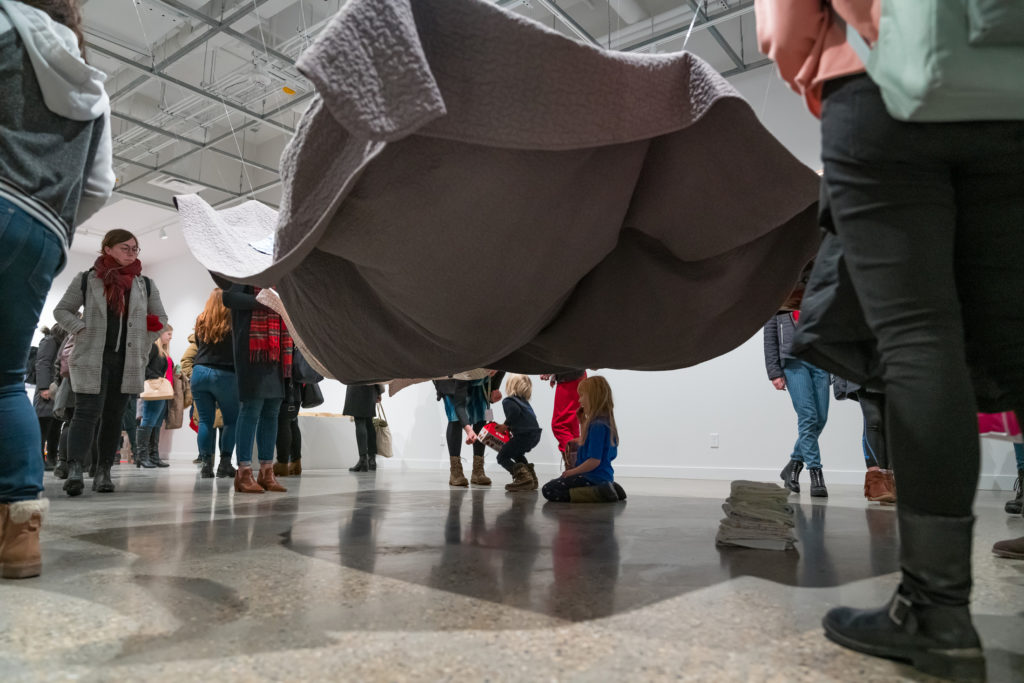 A view of Tiffany Shaw-Collinge’s installation Passage (2019) during a reception for “Mothering Spaces” at the Mitchell Art Gallery.
A view of Tiffany Shaw-Collinge’s installation Passage (2019) during a reception for “Mothering Spaces” at the Mitchell Art Gallery.
Through my particular lens and experience, I can state that, quite frankly, the lack of support afforded to caregivers in the arts is alarming. On top of the many other aspects that make existing in the arts difficult, there is a gendered dismissal of artists/curators/cultural producers after they give birth, with comments like, “There goes her career.” That sentiment is a misdistribution of the obstacles placed by structures like exhibitions, institutions, residencies and granting bodies.
Creating an atmosphere or support system where children are welcome to events, openings and sustained creative spaces increases access for everyone, not just Indigenous folks. The idea that art is separate from personal experience and is made in a vacuum is no longer recognized. But there’s still this big divide in arts-org practice: I’ve been witness to institutions commenting on the richness of a gathering and how great it is to have whole families in attendance, yet individual artists are paying out of pocket for childcare. (Really, costs covered by institutions should include putting the individual and their children up, and meals for the individual and the children, as well as money for activities and outings.)
In other words, residencies or programs that have children present are often celebrated by institutions; but they not actually facilitated by institutions through child-specific spaces and activities, or through childcare. Creating specific budget lines, organizing grants and hiring staff to facilitate activities and support are clear, straightforward actions across the board that would make “opportunities” for underrepresented communities more feasible, and which would deconstruct some of the difficulties of working in the arts.
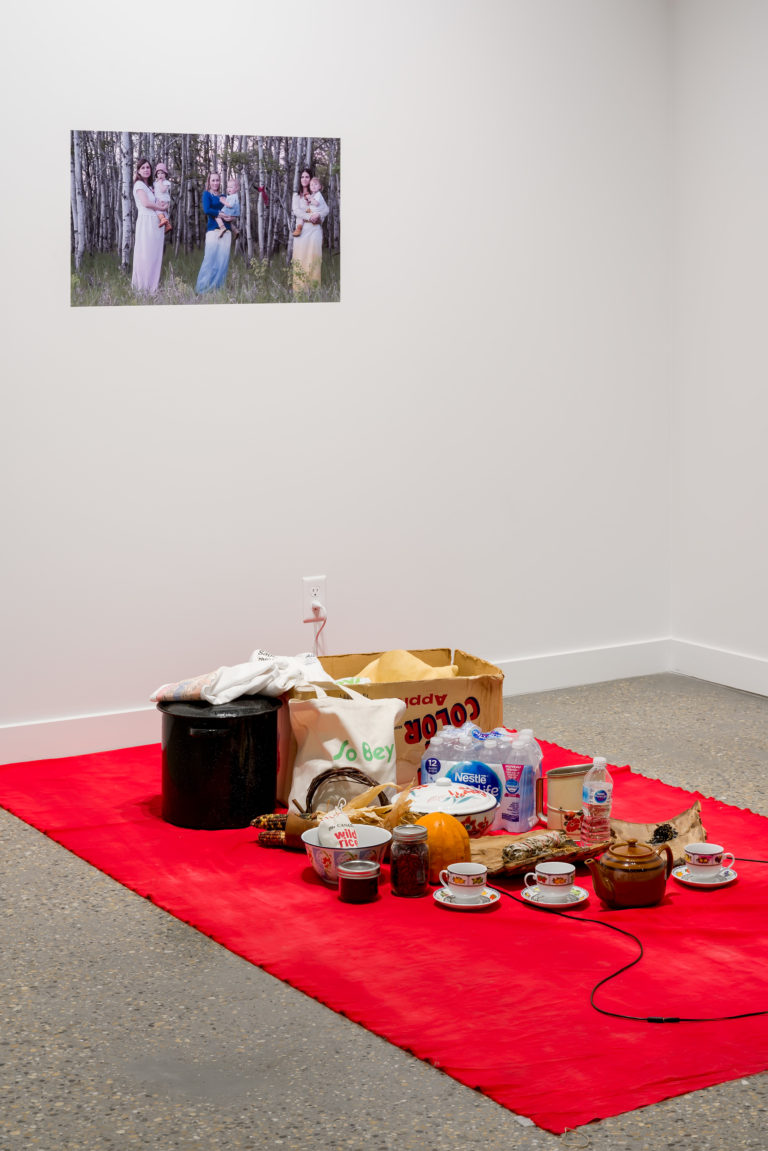 A view of So Bey (2019), and installation by The Ephemerals in “Mothering Spaces” at Mitchell Art Gallery. Photo: Blaine Campbell.
A view of So Bey (2019), and installation by The Ephemerals in “Mothering Spaces” at Mitchell Art Gallery. Photo: Blaine Campbell.
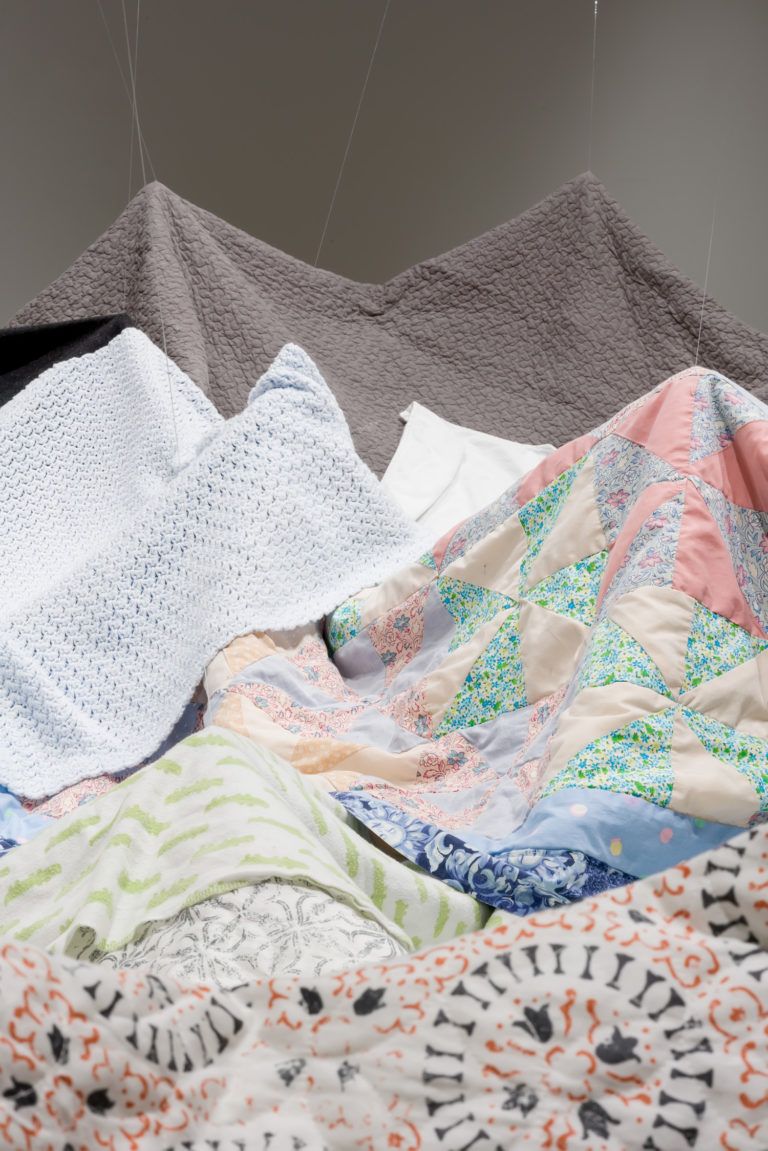 Detail of Tiffany Shaw-Collinge’s Passage (2019) in “Mothering Spaces” at the Mitchell Art Gallery. Photo: Blaine Campbell.
Detail of Tiffany Shaw-Collinge’s Passage (2019) in “Mothering Spaces” at the Mitchell Art Gallery. Photo: Blaine Campbell.
I’ve struggled writing a conclusion for this article for several months. The scope of this discussion is massive, and the impact of the show is one I cannot emphasize enough.
“Mothering Spaces” celebrated artists’ strategies of integrating culturally specific intergenerational conversations with their art practices in a way that is conscientious of ethics. Yet there are questions that natter away at me: What is going to happen outside of this one specific gallery that has committed to continuing to support caregiver artists they are exhibiting through travel, per diems and accommodations that include children? How do we continue these conversations beyond the period of this show? Many cultural producers who are caretakers spent time discussing this show and these topics with me, and it’s clear that we need more opportunities to do so.
I feel haven’t written a satisfying conclusion because there’s no satisfying answer to any of these questions. This dialogue needs to be consistently brought forward if we’re serious about changing the current structures.
If it’s already acknowledged and celebrated that artists with families, especially womxn, are producing art despite these barriers, why haven’t we taken the next steps toward dismantling them? This conversation needs more space, more time and more of the thoughtful and meaningful probing that Tiffany Shaw-Collinge, The Ephemerals, Faye Heavyshield and Becca Taylor have exhibited within and beyond “Mothering Spaces.”
 Performers in The Emphemerals’ So Bey (2019) arrive at the Mitchell Art Gallery for “Mothering Spaces.”
Performers in The Emphemerals’ So Bey (2019) arrive at the Mitchell Art Gallery for “Mothering Spaces.”

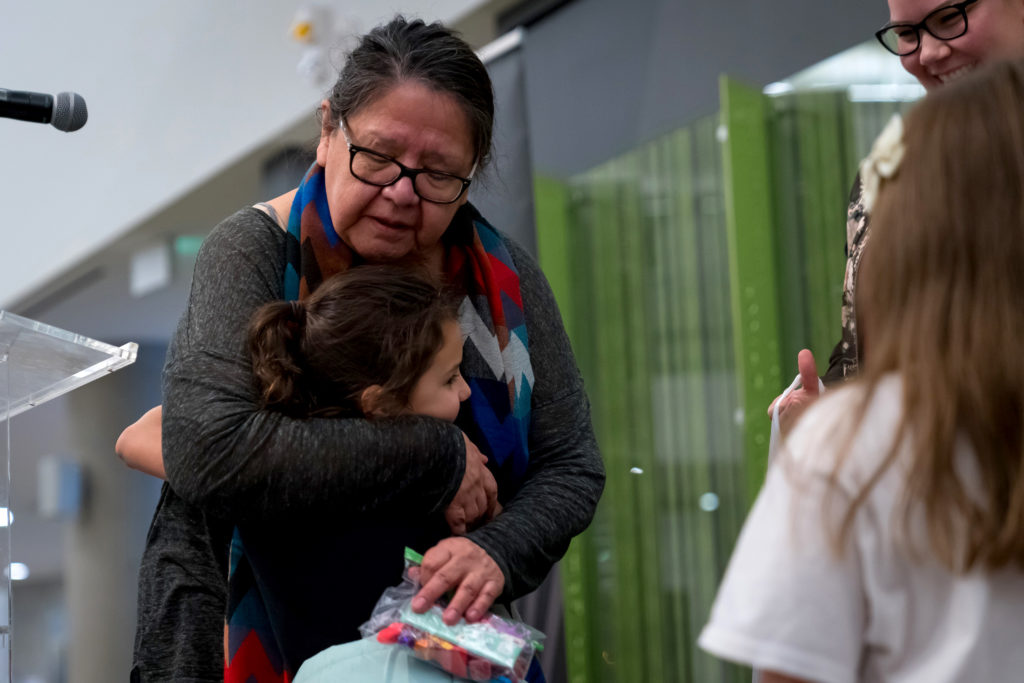 Artist Faye HeavyShield, as part of her involvement in “Mothering Spaces” at Mitchell Art Gallery, gave out gifts of creative materials to children.
Artist Faye HeavyShield, as part of her involvement in “Mothering Spaces” at Mitchell Art Gallery, gave out gifts of creative materials to children.
